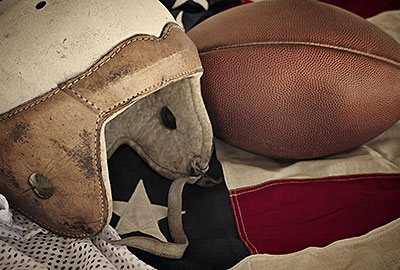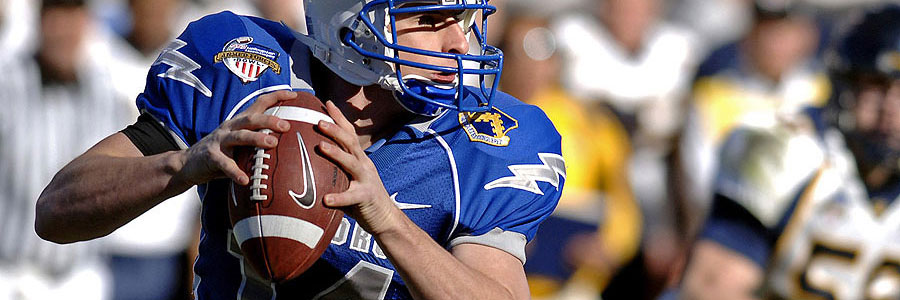 2021-10-07
2021-10-07

History of College Football
- ArticlesandContent.com (CIRCA 2005)
- /
- Oct 8, 2021 (written 2005)
As colleges formed teams and had to come up with a standard of rules everyone could follow, American college football was born.
The first meeting to establish these rules occurred on October 18th, 1873 in New York City when members of Yale, Columbia, Rutgers and Princeton met. But the evolution of the game of football as we understand it today grew out of a competition between Harvard University and McGill University where the two styles of sport each team had been playing were fused. Harvard adopted these rules and spread them in America.
Also it is important to note that Walter Camp, often referred to as the “Father of American Football” was responsible for declaring many of the specific rules of football. He also selected the earliest College Football All-American Team.
First College Football Games
The first technical game of college football was played in New Brunswick, New Jersey on November 6, 1869. The game was played between Rutgers University and the College of New Jersey, now known as Princeton University. This game was much closer to soccer than modern day football, however. The first game of college football played the way it is recognized today was played between Harvard and Yale in 1875 following the Harvard, McGill game.
Popularity of Early College Football
During the early days of college football the game became popular with athletes as well as spectators. The games were reported on in local and national papers and rivalries began to spring up. Some of the earliest rivalries include Army – Navy, which began in 1890, Pittsburgh and West Virginia, which began in 1895, Boston College and Holy Cross, beginning in 1896, Harvard and Yale (the oldest) dating from 1875, and Auburn and Alabama, beginning in 1893 and remaining the fiercest of rivalries in college football history.
History of Bowl Games
Championship college football history began when the Tournament of Roses Association sponsored a game between Michigan and Stanford in 1902. The outcome of that game was 49-0 Michigan. The association began holding a contest every year based on that game, and eventually the contest was played in the newly completed Rose Bowl Stadium, where the name came from. By 1940 five other bowl games had been created: the Rose Bowl, the Orange Bowl, the Sugar Bowl, the Sun Bowl and the Cotton Bowl.
History Of College Football Bowls
In 1869, colleges began to have their own separate football teams that would compete against each other. While the competition was nothing new when it came to sports, the setup of the competition was something different and alluring. Columbia, Harvard, and Yale were some of the first schools to invest in the college football games that would be played.
In the 1880’s, the rules of college football were revised, and with the revision came a new appreciation for the sport and the colleges that played. In 1915, numbers were finally added to the jerseys of the players, so they could easily be identified. As more and more people became interested in the sport, bigger and better competitions were held; the most exciting of these were referred to as college football bowls. College bowls have grown in popularity, and today are covered by many sports news channels. Additionally, gambling on different college football bowls has also become popular and helped add to the number of spectators for the college bowls.

Famous College Football Bowls
The Alamo Bowl: The modern college football bowl referred to as the Alamo Bowl was initially started in 1993. Recently, the full title of the college bowl was changed to the Valero Alamo Bowl. Out of all the college bowls, the Alamo Bowl has produced eight out of the twenty most popular and watched college football bowls as broadcast by ESPN.
Fiesta Bowl: Initially, the Fiesta Bowl was strted by the Western Athletic Conference. The Conference was frustrated by the fact that they had been thus far unable to receive any invitations to the existing college bowls. In the last two years of the 1960’s, Wyoming and Arizona State, both championship teams, were not given invitations to any of the existing college football bowls. The Fiesta Bowl created a tie-in for the snubbed Conference teams.
GMAC Bowl: Previously referred to as the Mobile Alabama Bowl, the GMAC Bowl hosted the highest scoring college bowl game of all time. In 2001, the score rose to 61-64 in double overtime. The Marshall Thundering Herd overcame a substantial deficit in order to beat the East Carolina Pirates in one of the most impressive college football bowls.
Gator Bowl: The first of the Gator Bowls took place in 1946. In 2007, CBS Sports televised the Gator Bowl and the payout for the invited teams rose to $2.5 million. of the college football bowls, the Gator Bowl is one of the sporting highlights for the city of Jacksonville, Florida, the location of where the bowl is hosted.
Orange Bowl: Most often played during the first week of January, the Orange Bowl takes place in Miami, Florida. In 1998, the Bowl Championship Series system was created, and as a result, the Orange Bowl was linked to the other three football college bowls that are considered to be the Bowl Championship Series college bowls. The four championship college bowls are comprised of the Orange Bowl, the Sugar Bowl, the Fiesta Bowl, and the Rose Bowl.
Rose Bowl: Of the available college bowls, the Rose Bowl is the game that is most often played on the first of January, New Year’s Day. Since the Rose Bowl is the oldest of any college football bowls, it is affectionately referred to as “the granddaddy of them all.” The Rose Bowl was originally titled as the Tournament East-West football game, and the first game took place back in 1902.
Sugar Bowl: Three college football bowls started in 1935: the Sugar Bowl, the Orange Bowl, and the Sun Bowl. The Sugar Bowl is played in New Orleans, Louisiana and is the oldest of the college bowls, second only to the Rose Bowl, which was started in 1902. During the 2005-2006 Sugar Bowl, the participating teams each received a payout of between $14 and $17 million.
More From Sports
 2021-10-07
2021-10-07